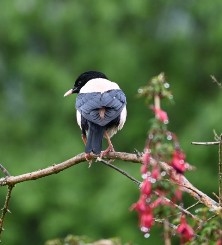Rosy Spell
Reports



Between Monday 14 and Friday 18 June I received nine records of Rosy Starling, also known as Rose-coloured Starling. For example, on Wednesday 16 June I received records from Brodick, Lamlash, Sliddery and Strathwillan. In the latter area two birds were reported. Often the birds were coming into gardens with Common Starling. Rosy Starling are well named beautiful birds. It is a rare vagrant on Arran. In recent years there have been reports of a single bird in 2002, 2017, 2018, 2019 and 2020. This year with three possibly four birds on the island at the same time has been unprecedented.
Where had they come from? The breeding range of Rosy Starling is from easternmost Europe across temperate southern Asia. It is a strong migrant, and winters in India and tropical Asia. It is a bird of steppe and open agricultural land. In years when grasshoppers and other insects are abundant, it will erupt well beyond its core range, with occasionally significant numbers reaching western Europe and the UK.
In their natural habitat they are highly gregarious birds, and often form large, noisy flocks, which can on occasion be a pest for growers of cereal crops or orchards. On the other hand, they are also greatly beneficial to farmers as they prey on pests such as locusts and grasshoppers, thereby limiting their numbers. For example, in Xinjiang province in China farmers build artificial nests to attract the birds and the birds help control locusts reducing the use of costly polluting insecticide.
The birds breed in tight colonies in a very short breeding season timed to take advantage of peak abundance of grasshoppers during May to June. It is during dispersal after breeding that some birds stray into north-west Europe. This has been such a year with numerous records across north-west Europe.
Males in the breeding season have elongated head feathers which form a wispy crest that is fluffed and more prominent when the bird gets excited. In winter, the crest is shorter, and the edges of black feathers within the plumage become paler as the edges of these feather erode. Winter plumage in males is comparatively dull. Females in contrast have a short crest and lack the sharp separation between pink and black. The juvenile birds can be distinguished from Common Starling by its obviously paler plumage and short yellow bill. Young birds moult into a subdued version of the adult plumage in autumn. These lack the crest. They do not acquire their adult plumage until they are nearly one year old in females, and nearly two years in males before they get the crest. From the photographs received both male and female birds have been on Arran this week.
Please share all sightings with me.


